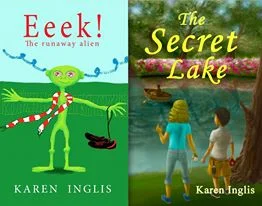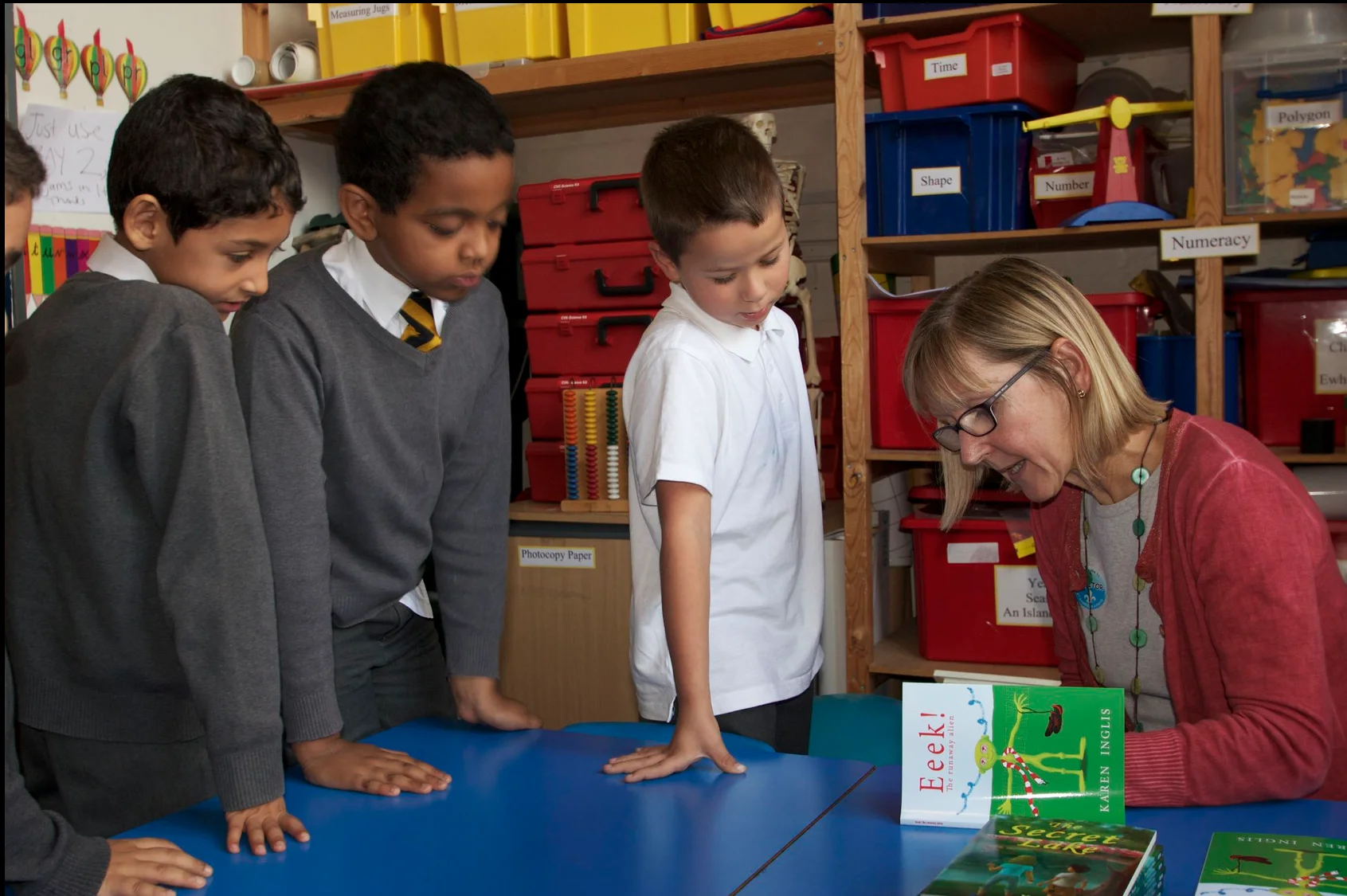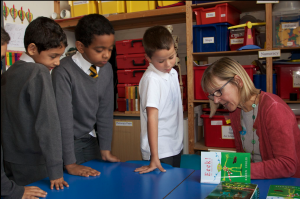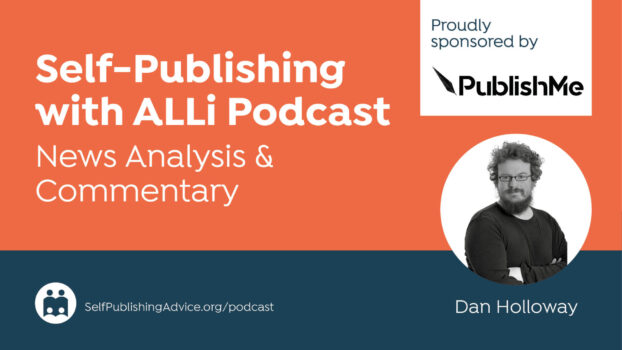 Self-published children's author Karen Inglis, with three children's books and a new children's book app to her name, shares her top tips for marketing books for a young audience. (More news on her app to follow soon!)
Self-published children's author Karen Inglis, with three children's books and a new children's book app to her name, shares her top tips for marketing books for a young audience. (More news on her app to follow soon!)
When I first published The Secret Lake, I felt envious of authors of books aimed at teens and adults as I watched them tweeting and sharing away with their target audience. How lucky they were! I had no such opportunity as my target audience of 8-12 year olds aren’t supposed to be on Facebook, Twitter or other social media sites. Even if they were, they wouldn’t be holding the debit or credit card!
So just how does a children’s author reach out to his or her readers? I think there are two key ways – and while we children’s authors may be at a disadvantage in the online world by not having direct access to our readers, we are at huge advantage in the ‘face to face’ world. What I’m about to share isn’t rocket science, but I hope this will be of help for anyone just starting out trying to market their children’s book. Here are six ways to reach your readers – three online, and three face-to-face.
 Reaching readers online
Reaching readers online
- Seek out places that parents of children in your target age range hang out online – such as your local community’s parents' website, the local branch of parenting blogs and other parenting blogs farther afield. You can find many of these via Twitter using hashtags such as #parentng, and via Google. First check the rules about self-promotion (the British parenting website Mumsnet once locked me out for mentioning The Secret Lake once too often!) Then get involved in an appropriate way. That may mean anything from joining in discussions about children’s books and literacy, to volunteering yourself for an interview, to donating signed copies of your books for party bags, to offering to do a local reading and signing. Make sure that any profile you set up mentions that you write for children and, if allowed, include a link to your blog or website.
- Google to find children’s book review sites at home and abroad, and offer yourself up for interview. Again, it’s the parents of your readers you’ll be reaching out to – but as they have the purse strings, this is how you will get your books into children’s hands. Once the interview is up, you can tweet and share it using #childrensbooks #kidsbooks #parents and similar hashtags to help raise your profile even more widely. A good quality site that I have used in the USA is The Children's Book Review, which has an Author Showcase area with a range of interview options from free to $50 or more. They tweet the interviews, and their articles seem to get re-blogged/syndicated. Search for my name and you’ll see how they covered me. Librarians often read these sites too. There are plenty of other blogs offering free interview spaces – just search online!
- Create a place on your blog or website (you do have one, don’t you?!) where children can leave reviews of your books or ask you questions. Tell them at the end of your print or e-book how to find it. You need to ensure that their details remain private. Ask them for parents’ permission to post. See my children’s reviews page on The Secret Lake website for an example. You don’t need a website for every book by the way – I do at present, but I may bring then all under my more recent ‘catch-all’ author site.
- Send an email to your nearby schools and offer to go in and do a reading of your book(s). Be sure to say what age range the book is aimed at, and therefore which classes you would envisage visiting, and attach or embed in your email a thumbnail copy of the book cover, a plot synopsis and links out to reviews on Amazon or your website. Follow the email up with a phone call, and take it from there. Say that you visit local schools for free in return for the school sending slips home offering the chance to buy signed copies of the book. If the school goes ahead, offer to send a summary sheet and tear-off slip that the school can use if they wish. The more control you have of the message, the more likely you are to get the sales you would like! If travelling father afield, you’ll need to work out travel time and costs, and decide whether you wish to charge a fee. Top tip: give a really professional look by including links to your books/blog & tiny thumbnails of you book covers as part of your sign-off.
- Offer to do a reading in your local library one weekend and provide signed books in return. Help promote it by putting up simple posters locally where parents hang out.
- Offer to do a book signing in your local bookshop if it stocks your book. Again, put up posters or do mail-drops locally in areas with lots of young families, or hand out leaflets at school gates. If your book is also available online, you could mention this if you want to, for those who don’t make it face to face. If there’s no nearby bookshop, consider offering signed copies for collection from your home.
Above all, enjoy!
Don’t be nervous about meeting your readers – children love author visits! But be sure to plan what you’ll say before your reading, and leave time to take questions afterwards. I ask schools to send me an advance list of orders to enable me to pre-sign and dedicate books. If you don’t do this, it can take up a lot of time at the end of the session. I find that around 50% of a class tends to buy (sometimes a lot more). Where numbers are low, it’s usually because the school hasn’t been very efficient at sending slips home. Good luck!






I know a few authors trying to get their name our there and what has worked for some of them is engaging on the social media sites for big children’s book retailers . They have a huge audience and you can be guaranteed that the audience is correct. It’s always worth a try and there is nothing to lose. A friend of mine got good exposure when in engaging with this site: https://childrensbookoutlet.co.uk/blogs/news/homeschool-swap-the-tablet-for-good-children-s-books
Thanks for this Karen! This is very helpful..
Thank you so much for this article. It put me at ease. I wanted to ask in terms of self published children authors, are they eligible to charge a fee for their author visit?
I have two self-published children’s books- The Gymnastics Nightmare and Blankie Boo and Baby Makes Two. I am selling them on Amazon, Barnes and Noble and many other small book stores but I just can’t seem to get momentum. Your ideas are great and very appreciated!
You are a sweetheart! Always coming up with easy solutions and really practical ideas.
Hi- I’m late in the convo too but hopefully someone can help me. I am a self published children’s author and the ride has been a great one but as a novice I’m looking for advice specifically on how to write a proposal for a school district to purchase my chidlren’s book. I wrote an anti bullying book for young children and a very large school district has asked that I write them a proposal in order to purchase my book in large quanities for thier schools. I have no idea where to start. I’ve written plenty of press releases and synopsis and all that for my book but for a school district to purchase in large quanity I have no idea what info is beneficial for them to include me in the budget for next year to purchase. How does a self publiuched childrens author create a propsal for a school district purchase? thank you!!
Hi Felicia – I can’t claim to know the answer here – it’s already clear that they are sold on the book in terms of how it fits with learning needs and the social side of curriculum so this feels to me very much like a financial proposal they are looking for – giving costs for bulk buy and showing them what a good deal they would get.
I’d probably be honest with them and ask them upfront what key elements they’d like to see in the proposal to ensure that you give them what they need in order to make a decision – (even ask if they’ve any sample ones they can let you have with the figures scrubbed out??) Once you know the format/required content then you’ll need to get on with finding quotes I am guessing.
Another thought is to check which printers currently supply schools and approach one to ask for their advice – after all it will be their quotes that ultimately feed into this type of proposal.
Either way it’s *fantastic*! You’re really being asked to ‘bid’ for a contract. I’d keep it as plain English as you can once you know what they need. You may also need to ask for legal /accountancy advice too if you think the order would really go ahead – to ensure you don’t commit to something you can’t fulfill and work out the cashflow etc…
These are all top of my head ideas so anyone else seeing this feel free to chip in….
One last point – you’d clearly need to ask them what number they would want to order (or range of numbers).
thank you Karen! very useful advice!
Hi,
Late to the conversation, but just wanted to say that I found a fantastic illustrator on freelancer.com. I paid her a fixed amount for a fixed number of illustrations -I own all rights.
-I sent her the text and a proposed storyboard. We then discussed the characters and what the overall look and feel should be.
-After a few weeks, she submitted her sketches and we discussed changes based on this. Then she created the illustrations digitally over a 2-month period.
I am very satisfied with the work and found it to be a very straight-forward process.
Ingrid
Hi Ingrid – I found my illustrator on elance.com too – and own all the rights. It would be really helpful for other readers if you could find a moment to pop over to my blog and leave comment about how you found yours on my page on self-publishing a children’s picture book…. Here’s the page http://kareninglis.wordpress.com/self-publishing-a-childrens-picture-book/
Ah – I see you used freelancer.com – but also a useful tip 🙂
Hi Ingrid,
I’m about to search for an illustrator for a childrens book I have written. I have no idea what the going rate is?? I’m sure it can vary quite a lot, but I was wondering if you could let me know a ball park figure, either per page or per book that you paid, or that you are aware people normally pay illustrators?
Many thanks
Louise
We have a few posts lined up about illustration over the next couple of months, so follow the blog to make sure you don’t miss them!
Hi Louise – I don’t know that there is a going rate really. I think it best that you contact a few illustrators and ask them for a ball park quote – because the price is only relevant if the illustrator uses a style that you feel fits your work..
One easy way to get a range of figures informally might be to go onto Linkedin and join one the children’s and authors illustrators’ groups (eg this one – http://www.linkedin.com/groups/Childrens-Book-Illustrators-Authors-1613217 )and ask the question there. Or post the job on elance.com (but their site is down at the moment…) or http://www.freelancers.net/ and get quotes…
You can also look on http://www.childrensillustrators.com/talent-pool/ and then ask for a quote from anyone whose work you like the look of. I hope this helps. Look out for the upcoming posts Debbie mentions too…
Hope this helps,
Karen
Karen Inglis,
Thank you for the LinkedIn link. (sounds redundant 🙂 I published my book last month and wanted some company on the journey.
Karen,
Thank you so much for sharing this advice – so many fantastic ideas and exactly what I needed. I am just about to embark on self publishing my first children’s book and although exciting, it is also a very scary prospect. Having looked at your great website though, I can see that there are many things you can do to make it successful and it has started to spark a whole host of ideas that I can start to develop to market my book effectively. Encouraging to know you can make it work.
I’m glad you found it useful, Ruth! And best of luck with your book! Karen
This is just what Im looking for, Thank you for sharing these great tips. I learned a lot.
My pleasure, Peter – I’m glad you found it useful! Have a great New Year! Karen
I have go through quite a few outstanding information the following. Definitely worthy of bookmarking regarding revisiting. I’m wondering that the ton try out you set to create these excellent insightful web page.
Karen – thanks for this! I’ve just started to build up my ideas bank for promoting a book I’m publishing next year…the parenting site suggestion is one I hadn’t considered.
My experience so far is that nothing beats word of mouth – I tested my first few short stories on a few readers, who shared them with their friends.
I think you’re right though, in that we have the problem of wining over two target markets – the ones with the money AND the ones who are going to read the book!
I’ve just discovered that you can sell your own products direct from the free WordPress Blogs so have just set up a page – I’ve priced my books £2 above the RRP to cover postage and admin costs. I’ve no idea whether I’ll get any orders but will let everyone know! Here’s the link for info – but I will try to make it look more festive in the next couple of weeks 🙂 http://wellsaidpress.wordpress.com/special-orders
After deleting endless, useless blogs and links, how refreshing to find one that is really useful. Thanks Karen for sharing and thanks to ALLi for just being there. I find little time for other sites as you cover it all. I have one question about fees in the UK. I believe most schools have a budget to cover this and it is not unusual for authors to get paid to visit (and still sell books). I have done a few quite successful school visits for free so far (I sold 50 books at my last visit) but plan to charge a small fee next year. What’s the going rate?
Great website too Karen!
I was referred to the Society of Authors for ‘going rates’ on visits to schools, Christopher.
I’m not sure, Christopher – but I’ve seen children’s authors on blogs (I can’t remember which I’m afraid) say they charge anything from petrol costs to £50 + travel costs up to £300 a day… The higher day rate ones are where they stay the whole day and do literacy activities with the children I think.
Thanks Yes that’s the sort of fees I’d heard of too. I’ll let you know how I get on.
Thank you for this. I will be publishing my middle grade book in the next month or so. I’d thought of many, but not all, of these things. It’s good to have those confirmed and new ideas added.
My pleasure, Shannon.
I’m glad I’ve been able to add to your bank of ideas. It’s long-tail marketing but it’s worth it. And the other thing not mentioned here is to use local newspapers/magazines to cover your book launch from the ‘local author’ perspective. Send them a press release with book cover image and details (highlighting any local connections in the story, if there are any) and your photo/brief biog. Send by email and then call them up or call to get the relevant person’s name first if you need to.
All the very best, Karen
Does anyone have any thoughts about hooking up with artists for those of us interested in creating picture books, but who aren’t actually artists?
There are really two questions here: how to find the right person, and the nature of the commercial relationship. Mainly I’m thinking of paying upfront for ownership of the work versus taking on a creative partner who doesn’t require upfront payment, but who also shares in control and profits.
Hi Theo – I looked at lots of illustrator websites and eventually turned to elance.com to find an illustrator. But Linked-In seems very active; if you’re not there already I’d recommend becoming a member and checking out their Authors and illustrators’ group – and other children’s publishing groups. Re the rights, that’s something you need to negotiate with your illustrator – it seems to work both ways.
I found my illustrator through a painting she’d done at our local arts center. We are paying for ownership of the work, but of course her name will be on the book as the illustrator. She’s excellent to work with–very respectful of our ideas, and willing to contribute her own, not only about the art but also about the storyline. We couldn’t do better!
Theo, I think that would make a really good subject for a future blog post here. Any illustrators or illustrators’ agents like to volunteer? If so, just email debbie[at]allianceindependentauthors.org. Thanks.
To add to my comment, Theo – I happened across a discussion this weekend on Linked-In in one of those groups I mentioned. The thought there was that it’s hard to find any illustrator who would work up-front for free in return for a share of the profits as the book may not sell and that could be a lot of work for no return. However, an alternative to paying to own the rights yourself could be to pay the equivalent of an ‘advance’ against royalties. Here the advance would presumably cost less than paying for ownership of the all the rights. Anyway, for another blog post really, per Debbie’s comment below 🙂
Thanks, Debbie and Karen!
I can sort of handle having a creative partner or paying upfront… But I don’t know how I feel about paying an advance against future royalties.
I tend to think that if I’m carrying all the risk in case of a flop, I should be reaping all the rewards if it’s a hit.
I have paid for all of my illustrations Theo – for exactly the reasons you say. I do all of the marketing and take all of the risk. (I also closely brief the illustrations.) And, let’s face it, there’s not huge sums to be made in children’s publishing unless you strike gold!
I’m currently working on a project with a student I know who’s taking a degree in graphic art and illustration for a fixed fee – you could try asking your local art college for samples of portfolios. I wouldn’t have hesitated to talk to students in my own local art college/uni if I hadn’t known Laura…
Thanks, Katherine!